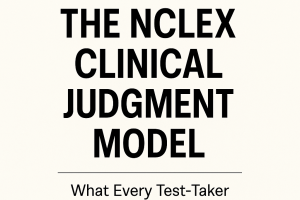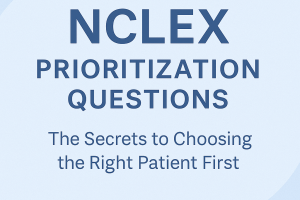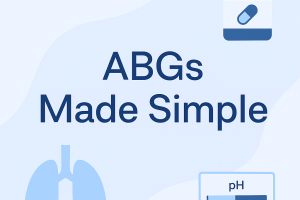Drug Interactions and Side Effects: A Guide for NCLEX Exam

Understanding drug interactions and side effects is essential for safe nursing practice and is heavily tested on the NCLEX exam. Medications can interact with other drugs, foods, and even certain conditions, leading to adverse effects or diminished efficacy. This blog post will cover the types of drug interactions, common side effects, and how to manage them, along with sample NCLEX questions to enhance your exam preparation.
What are Drug Interactions?
Drug interactions occur when the effect of one drug is altered by the presence of another drug, food, or substance. These interactions can enhance or reduce the effectiveness of the drug, or cause unexpected side effects.
Types of Drug Interactions
- Drug-Drug Interactions: Occur when two or more drugs interact, leading to an increase or decrease in drug effectiveness or causing adverse effects.
- Synergistic Effect: When two drugs enhance each other’s effects.
- Antagonistic Effect: When one drug reduces or blocks the effect of another.
- Additive Effect: When the combined effect of two drugs equals the sum of their individual effects.
- Drug-Food Interactions: Certain foods can affect the absorption, metabolism, or excretion of drugs, leading to altered drug effects.
- Grapefruit Juice: Can inhibit the metabolism of certain drugs, leading to higher drug levels in the body.
- Vitamin K-Rich Foods: Can decrease the effectiveness of warfarin, a blood thinner.
- Drug-Disease Interactions: Some medications can worsen existing health conditions or be less effective due to certain diseases.
- Beta-Blockers: May worsen asthma or COPD symptoms.
- NSAIDs: Can exacerbate conditions like peptic ulcer disease or kidney disease.
Common Side Effects
Side effects are unwanted or unexpected effects of a medication. They can range from mild to severe and vary depending on the drug, dosage, and patient factors.
- Gastrointestinal Effects:
- Nausea and Vomiting: Common with many medications, particularly antibiotics, chemotherapeutic agents, and opioids.
- Diarrhea: Can be caused by antibiotics (e.g., amoxicillin) and medications affecting the GI tract.
- Constipation: Common with opioids (e.g., morphine) and anticholinergics.
- Central Nervous System (CNS) Effects:
- Drowsiness: Common with antihistamines (e.g., diphenhydramine), sedatives, and some antidepressants.
- Dizziness: Often seen with blood pressure medications (e.g., beta-blockers) and certain psychotropics.
- Seizures: Can be a side effect of some antibiotics (e.g., imipenem) and withdrawal from benzodiazepines.
- Cardiovascular Effects:
- Hypotension: Can occur with antihypertensives (e.g., ACE inhibitors) and diuretics.
- Bradycardia: Common with beta-blockers (e.g., metoprolol) and digoxin.
- QT Prolongation: Certain antibiotics (e.g., levofloxacin) and antipsychotics (e.g., haloperidol) can prolong the QT interval, leading to arrhythmias.
- Allergic Reactions:
- Rash: Common with antibiotics (e.g., penicillins) and sulfonamides.
- Anaphylaxis: A severe, life-threatening allergic reaction that can occur with any drug, but is most common with penicillins, NSAIDs, and some anesthetics.
- Hematologic Effects:
- Thrombocytopenia: Low platelet count can be caused by heparin (HIT) and chemotherapy drugs.
- Anemia: Certain medications (e.g., zidovudine) can cause bone marrow suppression, leading to anemia.
- Leukopenia: Reduced white blood cell count, often seen with chemotherapy and immunosuppressants.
- Hepatic and Renal Effects:
- Hepatotoxicity: Liver damage can occur with acetaminophen overdose, certain antibiotics (e.g., isoniazid), and statins.
- Nephrotoxicity: Kidney damage can be caused by NSAIDs, aminoglycosides (e.g., gentamicin), and ACE inhibitors.
- Endocrine Effects:
- Hyperglycemia: Can occur with corticosteroids (e.g., prednisone) and some antipsychotics.
- Hypoglycemia: Common with insulin and sulfonylureas (e.g., glipizide).
- Thyroid Dysfunction: Amiodarone can cause both hyperthyroidism and hypothyroidism.
Managing Drug Interactions and Side Effects
- Medication Reconciliation: Review all medications a patient is taking, including prescriptions, over-the-counter drugs, and supplements, to identify potential interactions.
- Patient Education: Teach patients about possible side effects and interactions, including what to avoid (e.g., certain foods, alcohol).
- Monitoring: Regularly monitor patients for signs of side effects, especially when starting new medications or adjusting dosages.
- Dosage Adjustments: Adjust doses based on patient factors (e.g., kidney function, age) to minimize side effects.
- Switching Medications: If a patient experiences severe side effects, consider switching to an alternative drug with a lower risk profile.
- Emergency Management: Be prepared to manage severe reactions, such as anaphylaxis, with emergency interventions (e.g., epinephrine).
Sample NCLEX Questions
Question 1
A patient taking warfarin is advised to avoid eating large amounts of green leafy vegetables. What is the rationale for this dietary restriction?
A. Green leafy vegetables increase the metabolism of warfarin.
B. Green leafy vegetables decrease the absorption of warfarin.
C. Green leafy vegetables are high in vitamin K, which antagonizes warfarin.
D. Green leafy vegetables increase the risk of bleeding when taken with warfarin.
Answer: C. Green leafy vegetables are high in vitamin K, which antagonizes warfarin.
Question 2
A nurse is administering a dose of digoxin to a patient with heart failure. Which of the following is most important for the nurse to assess before giving the medication?
A. Blood pressure
B. Apical pulse
C. Respiratory rate
D. Serum potassium level
Answer: B. Apical pulse
Question 3
A patient with depression is prescribed an MAOI (monoamine oxidase inhibitor). The nurse should advise the patient to avoid which of the following foods?
A. Yogurt
B. Chicken
C. Aged cheese
D. Apples
Answer: C. Aged cheese
Question 4
A nurse is caring for a patient who is receiving a continuous infusion of heparin. Which laboratory test should the nurse monitor to ensure safe and effective treatment?
A. INR
B. aPTT
C. Platelet count
D. Hemoglobin level
Answer: B. aPTT
NCLEX Preparation Tips for Drug Interactions and Side Effects
- Know Common Interactions: Familiarize yourself with common drug-drug and drug-food interactions, especially those involving medications frequently used in clinical practice.
- Understand Mechanisms: Understand the pharmacokinetics and pharmacodynamics behind drug interactions and side effects.
- Patient Safety: Prioritize patient safety by knowing how to prevent and manage potential side effects.
- Practice Questions: Regularly practice NCLEX-style questions on drug interactions and side effects to reinforce your knowledge.
Conclusion
Drug interactions and side effects are critical concepts for safe nursing practice and the NCLEX exam. By understanding how different drugs interact and the potential side effects, you can provide better care for your patients and ensure you are well-prepared for the NCLEX. Keep studying, practicing, and applying your knowledge to excel in your nursing career






